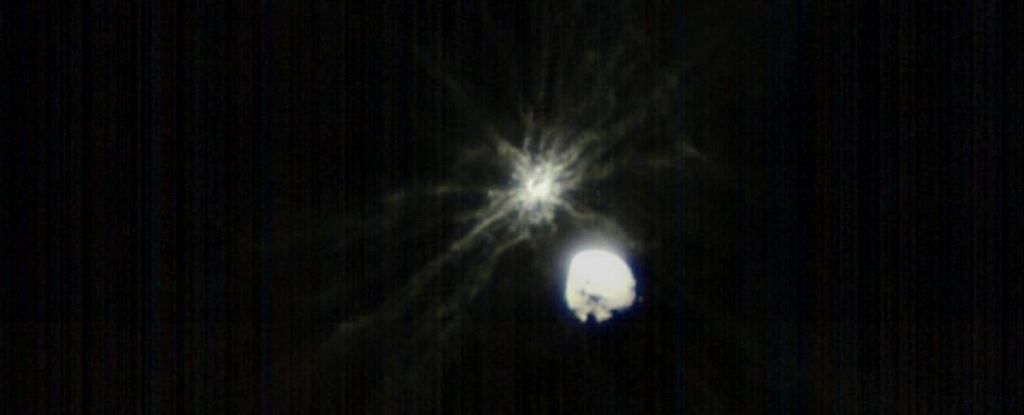In September last yearAfter years of careful planning and development, NASA crashed a spacecraft into a rock drifting through the solar system and was just minding its own business.
It wasn’t for sheer hatred of space rocks or delight in clashes; The motive behind this exercise was to test our ability to knock asteroid of course, in the interests of Earth security. And now we know we’re on to something. The measurements have arrived and the course of the rock has changed significantly more than expected.
A series of five articles describing this course deviation and the mechanisms behind it have been published in Nature.
Right now, the planet beneath our feet seems to be sailing serenely through empty space. But there happen to be a lot of big space rocks out there, and if one were to hit us, we were going to have a rough time. Just ask The dinosaur.
One way to deflect large asteroids coming our way is to crash into approaching rocks with a fast spacecraft. Momentum transfer from the spacecraft to the asteroid could change its trajectory through space just enough to divert it from its destiny with the Earth’s surface.
The Double Asteroid Redirection Test (ARROW) was an attempt to see if this is feasible. The target was carefully chosen: Dimorphos, a small moon orbiting a larger asteroid called Didymos. Since the orbital periods of the two objects have been well characterized, any change in Dimorphos’ trajectory would be detectable as a change in its orbital period.
About 160 meters (525 feet) in diameter, Dimorphos orbits the 780-meter-wide Didymos about once every 11.9 hours. The impact of DART was expected to change this orbital period by about 7 minutes.
As described in a paper Led by Northern Arizona University planetary astronomer Cristina Thomas, the change in orbital period was much more dramatic: Dimorphos is now orbiting Didymos 33 minutes faster than before the impact. Two separate measurements of the orbit using different methods gave the same result.
This larger than expected change in the orbital period of the binary asteroid system cannot be explained solely by momentum transfer from the DART spacecraft.
A piece of paper led by Planetary Science Institute astronomer Jian-Yang Li conducted a detailed study of the ejecta — the material ejected from the asteroid as a result of the explosive impact. It wasn’t just the immediate kaboom: for nearly two weeks after impact, Dimorphos continued Spit out cocks Dust, like a very dry comet.
A third paper, led by astronomer Ariel Graykowski of the SETI Institute in the US, studied the light reflected from Dimorphos before, during and after the impact. A little over three weeks after the collision, Dimorphos’ brightness returned to normal pre-impact levels. The brightness during this period indicated that the asteroid lost 0.3 to 0.5 percent of its total mass.
Accordingly a piece of paper Led by Johns Hopkins University Applied Physics Laboratory astronomer Andrew Cheng, this ejecta was responsible for most of the binary asteroid’s orbital change. This escaping material imparted more momentum to Dimorphos than was imparted by the DART spacecraft during its impact.
“Effects of DART” you write“Shows that momentum transfer to a target asteroid can significantly exceed the incident momentum of the kinetic impactor, confirming the effectiveness of kinetic impact in preventing future asteroid impacts on Earth.”
Finally, a team led by planetary scientist Terik Daly of Johns Hopkins University’s Applied Physics Laboratory the impact event is reconstructed from the data collected, including the timeline to impact, a detailed characterization of the impact site, and the size and shape of Dimorphos.
Your results are promising. Mankind can successfully deflect an asteroid off course with limited knowledge of its composition and surface conditions without first undertaking an expensive and lengthy reconnaissance mission.
Ideally, an asteroid deflection mission would be conducted decades before the projected impact. Fortunately, time is a resource we currently have in abundance: no asteroid that we know of will threaten Earth for at least 100 years. This gives us time for a series of peripheral threat reconnaissance missions, which would improve the chances of a successful diversion should things change in the distant future.
With that in mind, the information we have from DART is invaluable. It will help model and plan for future asteroid deflections when we need them to make better predictions about the outcome of spacecraft exploding in space rocks.
“The successful impact of the DART spacecraft on Dimorphos and the resulting change in Dimorphos’ orbit”, Daly and his team write“Shows that kinetic impactor technology is a viable technique to potentially defend Earth if needed.”
The research papers were published in Nature. They can be found Here, Here, Here, HereAnd Here.





